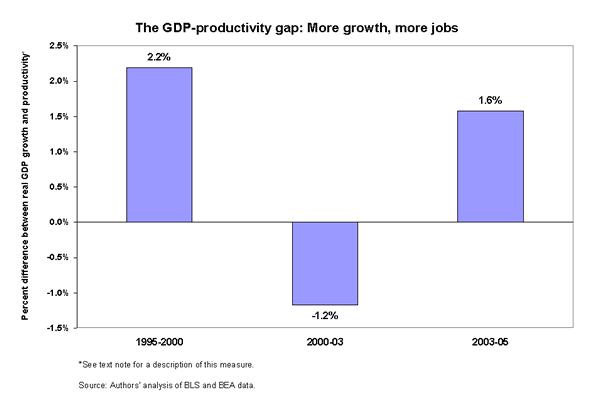See Snapshots Archive.
Snapshot for September 13, 2006.
Better GDP growth needed to add more jobs
As discussed in EPI’s latest Jobs Picture, the rate of job growth in the U.S. labor market has significantly downshifted in recent months. The average monthly gain over the past five months, for example, has been 119,000 jobs, a rate too slow to result in a job market that is tight enough to ensure that the benefits of growth are broadly shared throughout the workforce.
Underlying this recent slowdown in job growth is a fundamental relationship in economics: the rate of employment growth is, by definition, about equal to the rate at which real gross domestic product (GDP) is exceeding productivity growth. That is, if GDP is up 3% and productivity growth is up 2%, employment growth will be in the neighborhood of 1%.
The chart shows the difference between real GDP growth and productivity, reflecting the underlying growth rate of jobs in three different periods: the latter 1990s jobs boom, the jobless recovery, and the last few years.

In this context, our current lackluster job growth is no mystery. Over the past year, real GDP grew 3.5%, about one point faster than the annual growth in productivity. Intuitively, this means the economy has not been generating enough demand to lead employers to significantly expand their workforce (the 1% difference between these two values translates to about 112,000 jobs per month). As long as GDP is growing at about the same pace as productivity, there is little need to add workers to meet consumers’ and investors’ demands for goods or services.
Policy makers need to understand that, if we are going to get the jobs machine back into high gear, we need stronger real GDP growth to absorb the higher productivity growth we have been enjoying over this recovery. For example, were the difference between GDP and productivity to revert back to its 1995-2000 level (2.2%), we would be adding about 250,000 jobs per month, much more along the lines of the historical record for this stage of an economic expansion.
Data note: The values in the graph are the difference between real GDP growth and private-sector employment growth, plus the constant from a regression of the employment growth on the GDP-productivity growth. This additive value (0.6%) adjusts for definitional differences between the variables in question (e.g., GDP is for the total economy, productivity for the nonfarm sector; also, the economic identity in question is set in terms of hours worked, not jobs).
